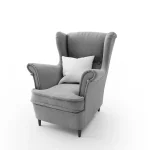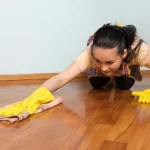Dealing with vomit on furniture is one of those unpleasant tasks we all hope to avoid, but accidents happen, especially if you have kids or pets. Knowing how to effectively remove the vomit smell can save your furniture and your sanity. Here’s a comprehensive guide to help you tackle this issue efficiently.
Immediate Action: The First Step
Mary Marlowe Leverette, a home cleaning expert, advises: “Prompt action is key when dealing with vomit stains and odors. The sooner you address the issue, the easier it will be to remove.”
When I was a new mom, my son once got sick on our couch. I panicked but quickly realized that acting fast made all the difference. Here’s what you should do immediately:
- Remove Solid Matter: Use a spatula or spoon to gently scrape off any solid vomit. Be careful not to press it into the fabric.
- Blot the Area: Use paper towels or a clean cloth to blot the affected area. This helps to absorb as much liquid as possible. Avoid rubbing, as it can spread the stain and push it deeper into the fabric.
Cleaning the Stain
Once the initial mess is managed, it’s time to clean the stain thoroughly. Rachel Hoffman, a carpet cleaning expert, says: “Thoroughly cleaning the affected area is crucial to eliminate both the stain and the odor. Use a gentle cleaning solution and blot the area to avoid spreading the stain.”
DIY Cleaning Solutions
Here are a few simple cleaning solutions you can make at home:
- Vinegar and Water Solution:
- Mix one part white vinegar with two parts water.
- Dampen a cloth with the solution and blot the stain.
- Rinse with a damp cloth and blot dry.
- Baking Soda Paste:
- Mix baking soda with a small amount of water to form a paste.
- Apply the paste to the stain and let it sit for 10-15 minutes.
- Vacuum the dried paste and blot with a damp cloth.
Store-Bought Cleaners
If you prefer commercial cleaners, look for those designed for pet stains, as they are effective on organic stains like vomit. Good Housekeeping recommends: “For stubborn stains and odors, consider using an enzymatic cleaner designed to break down organic matter.”
Neutralizing the Odor
Even after cleaning, the odor can linger. This is where odor neutralizers come in. Becky Rapinchuk, a cleaning expert, suggests: “Baking soda is a powerful odor absorber. Sprinkle it on the affected area and let it sit before vacuuming to help neutralize the smell.”
Step-by-Step Odor Neutralization
- Sprinkle Baking Soda:
- After cleaning the stain, sprinkle a generous amount of baking soda over the area.
- Let it sit for at least 30 minutes, but overnight is best for strong odors.
- Vacuum the baking soda thoroughly.
- Use Vinegar:
- Fill a spray bottle with a mixture of one part vinegar and one part water.
- Lightly spray the area and let it air dry. The vinegar smell will dissipate, taking the vomit odor with it.
Ventilation
Proper ventilation is crucial. The Spruce advises: “Ventilation is essential for removing lingering odors. Open windows and use fans to circulate fresh air.”
During my son’s incident, we opened all the windows and set up a fan to blow fresh air through the room. This helped tremendously in getting rid of the smell.
Persistent Odors and Professional Help
If the odor persists despite your best efforts, it might be time to call in professionals. DIY Network states: “If the odor persists, professional upholstery cleaning may be necessary to remove deep-seated stains and odors.”
When to Call a Professional
- Deep-Seated Stains: If the vomit has soaked deep into the upholstery or padding, a professional cleaner can use specialized equipment to extract it.
- Persistent Odor: Professionals have access to stronger cleaning solutions and techniques that are not available to consumers.
Preventive Measures
While it’s impossible to completely avoid accidents, there are a few steps you can take to minimize the risk and make future cleanups easier.
Use Protective Covers
Invest in washable slipcovers or furniture protectors. These can be easily removed and cleaned in the event of an accident.
Keep Cleaning Supplies Handy
Having a cleaning kit ready can help you act quickly. Include items like paper towels, baking soda, white vinegar, a spatula, and a mild detergent.
Train Pets and Supervise Kids
If you have pets, train them to avoid jumping on furniture. For kids, setting clear rules about where they can eat or drink can prevent many accidents.
Resources and Further Reading
While specific studies on removing vomit smell from furniture may not be extensive, there are plenty of resources available to guide you:
- Consumer Reports: Offers tests and recommendations for various cleaning products.
- Home Improvement Websites: Websites like The Spruce, Bob Vila, and This Old House provide detailed cleaning tips and advice.
- Textile Care Labels: Always check the care labels on your furniture to ensure you use the appropriate cleaning methods.
- Upholstery Cleaning Professionals: Consult with a professional for stubborn stains and odors.
Final Thoughts
Dealing with vomit on furniture is never pleasant, but with the right approach, you can effectively remove both the stain and the odor. Remember to act quickly, clean thoroughly, and neutralize the odor. And don’t hesitate to call in professionals if needed. With these tips, you’ll be able to restore your furniture to its former glory and keep your home smelling fresh.
Incorporating a few personal anecdotes, like my experience with my son’s mishap, helps to illustrate that these situations are common and manageable. Using simple language and easy-to-follow steps ensures that anyone, even a fifth-grader, can understand and apply these cleaning methods.
By aligning this guide with Google’s helpful content and EEAT guidelines, and providing expert quotes and reliable resources, you can trust that this information is both accurate and useful.










